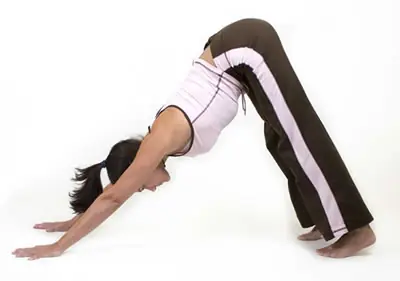The most basic and widely-known yoga pose is down dog. Even if you've never attended a yoga class, you most likely have heard of this one. However common the pose may be, it's often assumed and untaught in the yoga studio. Downward facing dog has many jobs and functions, among them--assessment pose, transitional pose, resting pose, strengthening pose, inversion pose and rejuvenator.
How To: Downward Facing Dog
The pose resembles that of an upside down letter V. Look at your hands--they should be shoulders-width apart and your wrist line (joint) should be parallel to the front edge of your mat. There should be equal space between each of your fingers and in general, your middle finger will point straight ahead.
It is very important that you engage or "plug" your entire hand fully into the ground at all times to avoid excess strain on your wrist joint. Your feet are hips-width apart and they are to remain parallel to each other, meaning your heel is directly behind your second toe. You would create a perfect square if you were to draw an imaginary line from left middle toe down to left heel, across to right heel, up to right second toe, and over to left second toe.
From there you will look at your lower leg or shin area. The shin area from ankle to knee will create a perfect rectangle when in the proper position. Your lower leg should never resemble a potential triangle, with your knees knocking in towards each other--this would risk tension on the inside knee. You should be supported equally by your upper and lower body, and not rest heavily in the legs. You will always be pushing the floor away and engaging the shoulders and the upper body, elongating, not sinking your neck into the shoulders and upper back. From a side view you will see a nice V--no rounding or arching in the back. See photo for an example. Beginners and those with tight hamstrings will start with bent knees.
Benefits of Downward Facing Dog

- Stronger hands, wrists, low-back, hamstrings, calves and Achilles tendon
- Decrease in back pain by strengthening the entire back and shoulder girdle
- Elongated shoulders and shoulder blade area
- Decrease in tension and headaches by elongating the cervical spine and neck and relaxing the head
- Deepened respiration
- Decreased anxiety
- Increased full-body circulation
For the lay person or yogi, downward facing dog elongates and lengthens the back. Think about how critical this is for an office worker who is hunched over at a desk all day. As a matter of fact, most people--from office workers to drivers, teachers and moms--are in a constant forward bend all day and would benefit immensely by stretching and lengthening the back shoulders and front body. Additionally, downward facing dog is a mild inversion since the head is lower than the hips, and inversions are great for increasing blood flow to the brain and eyes. And because it stimulates the nervous system, it also helps with memory and concentration.
For the athlete, this pose is essential for assessing postural needs and imbalances. It is an important habit for athletes to check themselves frequently for problems. This pose is a gentle way for athletes to open the hamstrings for quickness and speed, stretch shoulders, and keep wrists strong and supple--for grip strength in baseball and for pushing on the offensive line. Keeping the lower back open and strong, complimenting a strong core is important for agility on fields from soccer and football to tennis and golf. Finally, the pose helps to stretch toes, calves and arches, and feet--and having flexible feet translates directly to speed in any sport that involves running.
Although you should always consult your physician and research a properly-trained teacher before starting a yoga practice, there are a few instances where you should avoid this pose entirely: If you have a history of carpal tunnel syndrome, if you are in the late stages of pregnancy and if you experience sharp pains while performing the pose.
Have fun exploring this pose and learning about your body.


